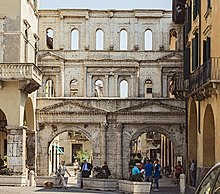Battle of Verona
The Battle of Verona was fought in 312 between the forces of Constantine I and those of Maxentius . The forces of Maxentius suffered defeat under the leadership of the able Ruricius Pompeianus , who died in battle. This opened the way to Rome for Constantine.
prehistory
After Constantine crossed the Alps and inflicted a severe defeat on Maxentius' forces at the Battle of Turin, most of the cities of northern Italy sided with Constantine. Constantine gathered his armed forces and defected troops from the northern Italian cities in Mediolanum . The march to Rome was about 400 miles on the Via Aemilia or the Via Flaminia . However, if Constantine's left flank were to advance on Rome, the city of Verona would endanger it. Verona had been developed into a strong fortress by Maxentius and lay in a bend in the river of Athesis . Verona was only accessible from the western side and could also get reinforcements and food from the river. Maxentius had left a strong garrison there under the leadership of his most capable general, the Praetorian prefect Ruricius Pompeianus .
Constantine advanced to Verona and defeated a strong detachment of cavalry at Brescia , which had been sent to meet him by Ruricus. Constantine surrounded Verona with a strong siege ring that also included the river. A failure of the ruricus could be rejected. Ruricus was able to flee the city, but not out of self-interest, but to come back with an army.
Slaughter process
Ruricus returned in August with an army that outnumbered Constantine's army. Constantine left some of his troops with the siege and advanced with his most reliable troops against Ruricus. Constantine only had his troops deployed in the duplex acies, the double battle line, but reduced the second meeting in order to be on a par with the first battle line of Ruricus. The battle took place towards the evening of the day, so that the courage and motivation of Constantine's troops decided the battle. During the fighting, Ruricus Pompeianus was killed, which severely affected his troops. Another failure of the city garrison was again rejected. The next morning the battle for Constantine was decided and a few days later Verona surrendered.
consequences
With the fall of Verona the way to Rome was free and many cities of Etruria and Umbria overflowed to Constantine. Constantine finally defeated Maxentius in the battle of the Milvian Bridge . Maxentius was killed in this battle and Constantine gained dominion in the west of the Roman Empire .
swell
- Eutropius , breviary ab urbe condita ,
- Zosimos , Historia Nea
literature
- Charles Matson Odahl: Constantine and the Christian Empire . New York 2004, pp. 84ff.
- Oliver Schmitt: Constantin the Great . Stuttgart u. a. 2007, p. 138ff.

